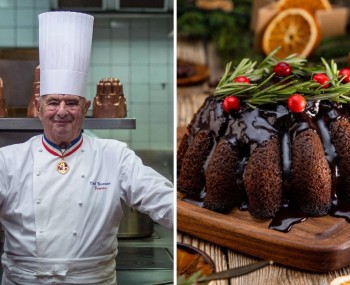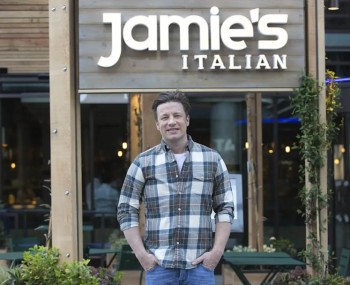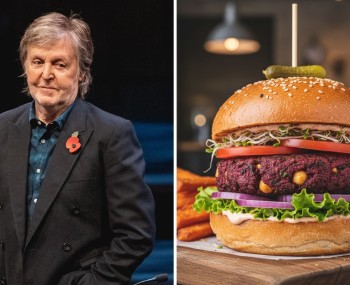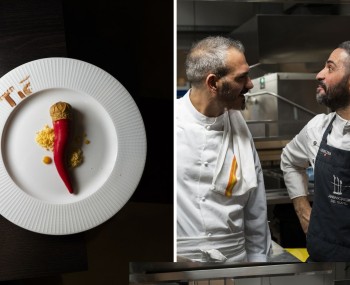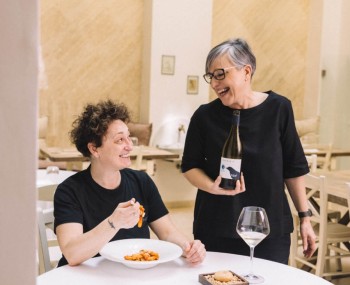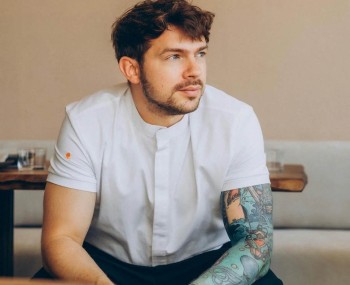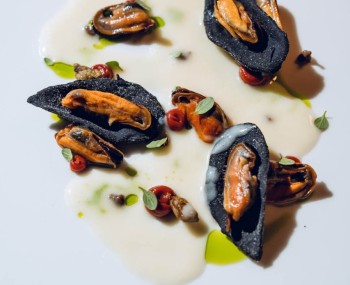He brought two stars to Munich's oldest building and today flies high with his multicultural cuisine. But Tohru Nakamura also has a clear vision of the future: “We must be open-minded and prepare things that are not always directly related to stars: I think this is much more important than how much caviar we can put on a plate.”
Photo credits: Oliver Forstner, David Egui, Hoang Dang
Munich is a vibrant, bright city: visiting it and falling under its spell is a sure thing. Especially when you find yourself in Marienplatz facing the magnificent, majestic silhouette of the Neues Rathaus, a neo-Gothic building that will leave you speechless. Every day, on its façade, you can watch the Glockenspiel, one of the largest mechanical carillons in Europe, which offers a beautiful show twice a day (three times from March to October).

Tohru in der Schreiberei, Tohru Nakamura's restaurant, is located a stone's throw away, in a house that dates back to the 14th century and was replaced by a stone structure following the great fire of Munich in 1327. In fact, the oldest building in the city, it was acquired in 1550 and became a chancellery: what is now on the first floor of an elegant old building on Burgstraße has become a notable gastronomic destination.


The chef and his philosophy
With a Japanese father and German mother, the chef told us how his father wanted him, being perfectly bilingual, to pursue a diplomatic career. However, things turned out differently because Tohru, like any self-respecting chef, had his heart set on cooking. His journey began with an internship at Lea Linster in Luxembourg, which sealed his fate. He recounts, “In reality, every restaurant I worked in before becoming a chef was formative and inspiring, such as the Königshof kitchen here in Munich.”

Then I trained at a three-Michelin-star restaurant in Cologne with Jochen Wissler at Restaurant Vendôme, which was my second stop and was quite challenging, although I learned a lot about discipline, structure, and precision there. Then I went further, to Sergio Herrmann's Aus Fluss, a very stimulating experience both in terms of atmosphere and work: here I understood how working together gives energy and makes a restaurant run like a well-oiled machine."

His other experiences include working with Sergio Herman at Oud Sluis, in Japan with Sushi Ito and Hassum, and at Kagurazaka Ishikawa. He earned his first two stars as head chef at the Werneckhof restaurant in 2016, which closed due to the pandemic. A brief stint at the Salon Rouge preceded the opening of Tohru in der Schreiberei in 2021, where the red-haired chef awarded his second star.

When we ask him how important it was for him to live in a multicultural environment, Tohru replies: "Well, it led me to the conclusion that, when it comes to cooking, I am also multicultural. If I hadn't grown up in a bilingual and multicultural world, my cooking style would be very different. I probably wouldn't use Asian ingredients, such as Japanese ones, or flavor profiles of that kind so readily. Since I grew up with them, it's normal for me to use miso or soy sauce or other typical ingredients. So maybe I would cook the same way, but perhaps taking them less for granted. In fact, we're working on that now because it comes completely naturally."

It is also interesting to understand his point of view on how much Japanese and German culinary culture is present in his cuisine. In reality, Tohru continues, "I don't think about it much. I imagine it also depends on how people describe it and the point of view of those who eat at our restaurant. For example, for Germans, our food tastes very Japanese. And I think, for example, that for Asians or Japanese people, our food is obviously more European or more German, since we use typical products such as butter or fresh cream or other things that are not normally found in Japanese cuisine. And our way of cooking is also, I would say, more European. Here, on the other hand, we cook many classic German dishes, reinterpreted in our own way. Ultimately, it's European cuisine with a more or less strong Japanese touch."

Tohru is a cheerful, direct, down-to-earth person and does not embody the typical image of a celebrity chef that we often encounter: "I think it's important for us chefs who work in a Michelin-starred restaurant not to be too focused on the world of haute cuisine. We need to be open-minded and also cook things that are not always directly related to the stars. Recently, for example, we organized a charity event where we cooked simple food, such as lasagna and other things like that. We did it to support groups or associations that work with disabled children and other difficult situations. And I think that's much more important than the usual talk about how cool we are and how much caviar we can put on a plate."
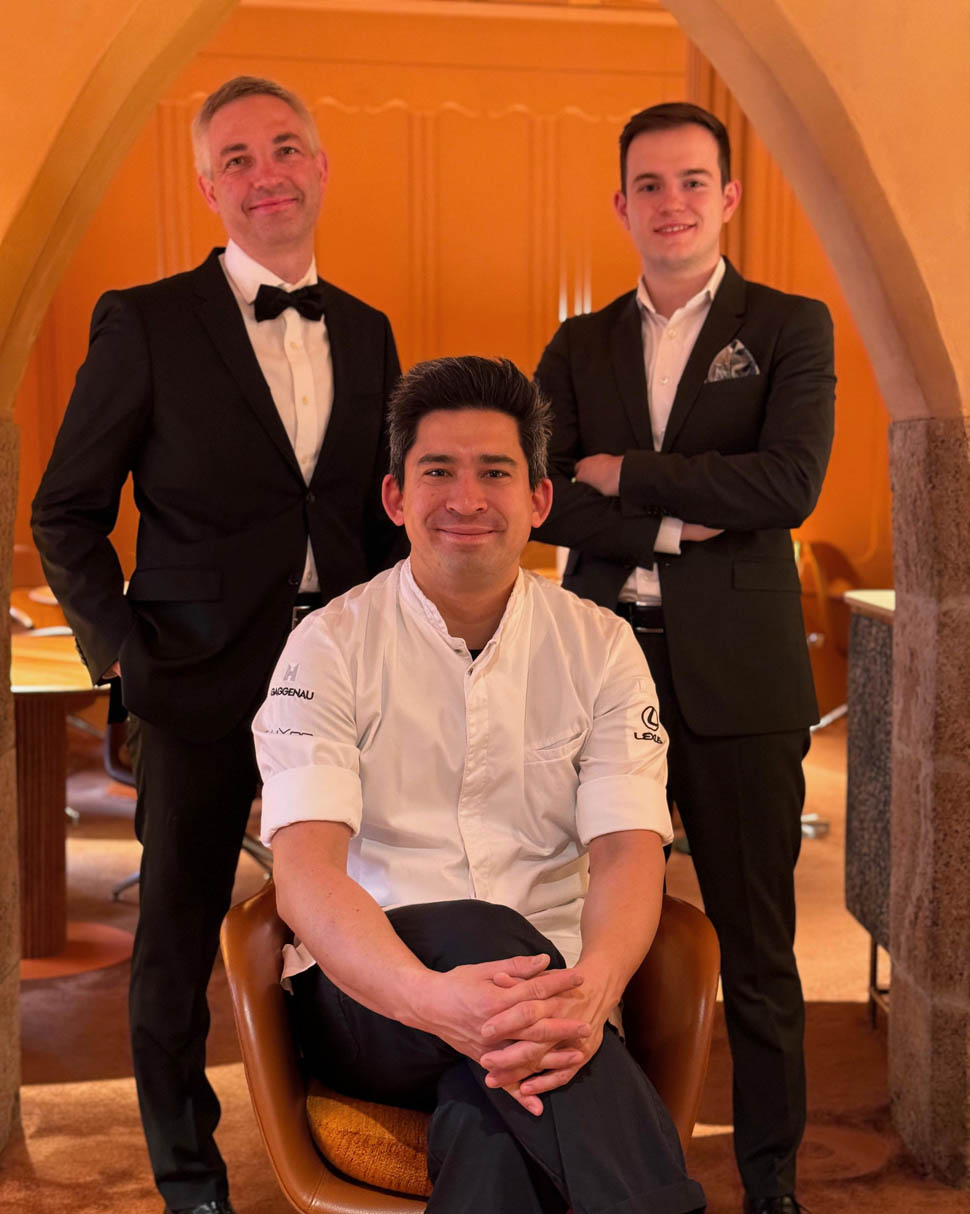
The dining room at Tohru in der Schreiberei is a place of great elegance, as is the staff, starting with restaurant manager Alexander Will and our old, prestigious acquaintance Christian Rainer, a Merano native with a long history at St. Hubertus in Val Badia, who is now maître sommelier here with a large wine cellar from which to choose important pairings.

The dishes
How do you eat here? Tohru's cuisine, beyond his own considerations, is first and foremost recognizable, original, and inimitable. We start with oysters lightly seared on the grill, which gives them a cooked texture on the outside while leaving them raw on the inside. They are served on a sort of mashed potato salad with a little chervil and Pommery mustard to add a nice touch of acidity. This is accompanied by a Mulsanne oyster cream and a crunchy buckwheat component, all paired with a jus of steamed mussels, Champagne, white wine, butter, and crème fraîche, which is intensely flavorful.

Also noteworthy is the wagyu nori in tempura, with a crispy sheet of nori seaweed dipped on one side only in the tempura batter and fried; the wagyu is marinated for about two hours with salt, sugar, and a little ground black pepper and then seared, is paired with smoked eel from Fresh Photo Farm near Monaco. There is also a kind of mayonnaise with habanero, which is paradoxically very delicate but with the same intensity of flavor, thinly sliced peppers, and a smoked eel dashi jelly. The next dish is based on Japanese rice from Hokkaido, the northernmost part of the country. Its name, Fukkurinko, refers to its texture: "In Japan, when something is really soft, it is called fukura. This is where the name fukkurinko comes from, which means that the rice is a little softer,“ the accompanying sauce is made with fermented shio koji rice, a little sake, a pinch of butter, and fresh cream, ”which doesn't make it more Japanese from my point of view," superselected Balfego tuna akami, miso, and a little genmai miso, a whole grain, multigrain miso.



Next up are fragrant white asparagus grilled over charcoal with a miso and shiso glaze. They are accompanied by a sauce made with green asparagus, chervil, and sorrel, with a touch of hollandaise sauce. Next to it is a jelly made with white asparagus cream and topped with Royal Belgium caviar: “Royal because the sturgeon grow in the Royal Lakes near the French border, on the Belgian side, in a small town called Ternoit. And yes, so the caviar can be described as royal Belgian caviar.” There are also beechnuts, edible seeds from the beech tree, in an emulsion and toasted, crispy chips and various aromatic herbs. The char comes from the same farm where the eel is sourced and is served as a tartare with diced radishes, caviar and a little horseradish. The sauce is made with crème crue from Brittany and flavored with a little smoked fish sauce.


“We send the scraps to Marco Shimizu, who is also half Japanese and half German, works in Berlin and makes miso, soy sauce and things like that. He takes them and puts them in a wooden barrel with koji salt and leaves them to ferment for about a year. What he gets is a delicious smoked fish garum that we use for crème crue.” Still on the plate, the crispy ‘cannellone’ made with grilled char belly like a rillette, along with dill and crispy fried skin. The next dish is also great: "Chawanmushi is almost a classic for us too. It's like a Japanese-style steamed custard, which in this case we've prepared with duck. We have a kind of roast duck dashi, which we mix with egg and steam. It resembles a flan, but Japanese style; we serve it with tiny, sweet, teardrop-shaped peas from nearby San Sebastian. Then there's a sauce made with sansho, a mountain pepper, and homemade duck prosciutto. Schmiddy, the son of a butcher, prepares this smoked duck ham that is placed on top of the chawanmushi. The dish looks very simple, but it's actually quite layered. There's also a pil-pil: we take the cocochas, marinate them in salt, then wash and season them with olive oil. It becomes gelatinous, as they say, with this soft texture." Wonderful.

Next comes the yellow cod: "Before portioning, the filets are placed in a 5% saltwater brine for about two hours. There is an emulsion of soybean sprouts and pickled spruce sprouts, pine nuts, and aromatic herbs. The sauce is made with macvin and sherry. We also add a drizzle of oil flavored with roasted fish bones.“ The approach for the veal sweetbreads is similar to that of karaage: ”We marinate them in buttermilk overnight, along with a little light soy sauce and shiokoji marinated inside with parsley and lemon zest. After marinating, we dip it in tapioca starch and then fry it: it becomes very, very crispy, while the inside becomes melt-in-the-mouth. It is placed on a julienne of cabbage and kimchi. The sauce is made from miso and brown butter. On top is the veal tongue, cut into thin slices, with sherry gel and pieces of a highly prized Galician anchovy, Don Bocarte. This is followed by the tender, flavorful pork filet from the Hermannsdorf estate: it is matured with shiokoji, Périgord truffle sauce, and dulcamara foam.

Then another remarkable bite: “We took inspiration from a recipe inspired by Madeleine, but we prepared it with black pudding, apples, and some roasted shallots. And then, together with artichokes and artichoke chips and a tarragon emulsion.” The sweet part begins with a dorayaki, which is a classic Japanese wagashi dessert, a kind of pancake, usually filled with red bean paste and anko: in our case, we fill it with white chocolate jelly. We also have tonka bean and rhubarb meringues. Then we come to the hanami tray: “At that time, it was cherry blossom season, the festival of flowers. That's why we chose hanami as the theme for the tray, with items inspired by flowers. And the last, fun dessert.”


There is a famous souvenir at Tokyo airport called Tokyo banana. It is a sponge cake filled with vanilla cream. "We made a banana mousse, toasting the peel in the oven. This gives it a dark, toasted flavor, almost like coffee. The sauce is made with dark chocolate and dark Bavarian beer. A touch of sesame inside makes it a little more flavorful. The ice cream is made with amazake, and then a little yuga, Japanese ginger flowers, and a little banana bread. And a little white sesame as a gel. Here you go." How beautiful.
Tohru In Der Schreiberei
Indirizzo: Burgstraße 5, 80331 München, Germania
Telefono: +49 89 21529172

